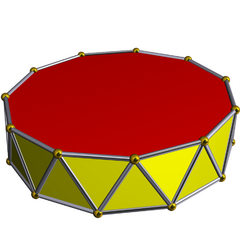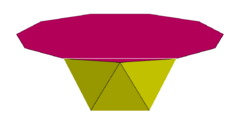Hendecagonal antiprism
From HandWiki
Revision as of 11:36, 1 August 2022 by imported>Wincert (link)
| Uniform hendecagonal antiprism | |
|---|---|

| |
| Type | Prismatic uniform polyhedron |
| Elements | F = 24, E = 44 V = 22 (χ = 2) |
| Faces by sides | 22{3}+2{11} |
| Schläfli symbol | s{2,22} sr{2,11} |
| Wythoff symbol | | 2 2 11 |
| Coxeter diagram | |
| Symmetry group | D11d, [2+,22], (2*11), order 44 |
| Rotation group | D11, [11,2]+, (11.2.2), order 22 |
| References | U77(i) |
| Dual | Hendecagonal trapezohedron |
| Properties | convex |
 Vertex figure 3.3.3.11 | |
In geometry, the hendecagonal antiprism is the ninth in an infinite set of antiprisms formed by an even-numbered sequence of triangle sides closed by two polygon caps.
Antiprisms are similar to prisms except the bases are twisted relative to each other, and that the side faces are triangles, rather than quadrilaterals.
In the case of a regular 11-sided base, one usually considers the case where its copy is twisted by an angle 180°/n. Extra regularity is obtained by the line connecting the base centers being perpendicular to the base planes, making it a right antiprism. As faces, it has the two n-gonal bases and, connecting those bases, 2n isosceles triangles.
If faces are all regular, it is a semiregular polyhedron.
See also
External links

